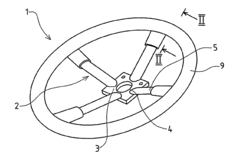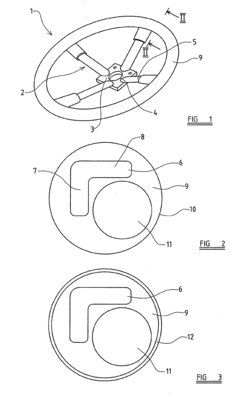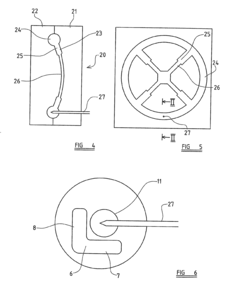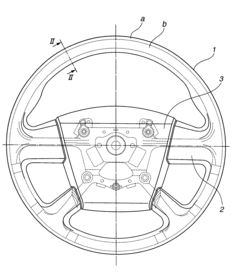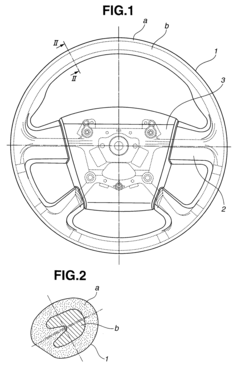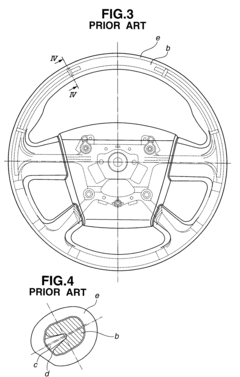Steering Wheel Innovations: Lightweight Materials for Efficiency
JUL 18, 202510 MIN READ
Generate Your Research Report Instantly with AI Agent
Patsnap Eureka helps you evaluate technical feasibility & market potential.
Lightweight Steering Wheel Evolution and Objectives
The evolution of lightweight steering wheels has been driven by the automotive industry's continuous pursuit of efficiency and performance enhancement. Initially, steering wheels were predominantly made of wood, transitioning to steel and later to various plastics and composites. This progression has been marked by a consistent focus on weight reduction without compromising structural integrity or safety.
In recent years, the objectives for lightweight steering wheel development have become increasingly ambitious. Manufacturers aim to reduce the overall weight of vehicles to improve fuel efficiency and, in the case of electric vehicles, extend range. The steering wheel, as a critical interface between driver and vehicle, presents a unique opportunity for weight savings while also enhancing ergonomics and functionality.
Current objectives in lightweight steering wheel research include the exploration of advanced materials such as carbon fiber reinforced polymers (CFRP), magnesium alloys, and even bio-based composites. These materials offer significant weight reduction potential compared to traditional materials, with some prototypes achieving weight savings of up to 30-40% over conventional designs.
Another key objective is the integration of smart technologies within the lightweight structure. This includes embedding sensors, controls, and displays without adding substantial weight or compromising the wheel's primary function. The challenge lies in balancing the incorporation of these features with the overarching goal of weight reduction.
Researchers are also focusing on optimizing the manufacturing processes for these advanced materials to ensure cost-effectiveness and scalability. Techniques such as injection molding of composite materials and 3D printing of complex, lightweight structures are being explored to achieve this balance.
Safety remains a paramount concern in steering wheel design. As such, a critical objective is to ensure that lightweight materials can meet or exceed the safety standards set for traditional steering wheels. This includes impact resistance, energy absorption during collisions, and long-term durability under various environmental conditions.
The automotive industry is also setting ambitious targets for sustainability in steering wheel production. This includes developing recyclable or biodegradable materials for steering wheel components and implementing eco-friendly manufacturing processes. These objectives align with broader industry trends towards circular economy principles and reduced environmental impact.
Looking ahead, the evolution of lightweight steering wheels is expected to continue with even more radical designs and materials. Concepts such as steer-by-wire systems may lead to completely reimagined steering interfaces, potentially eliminating the need for a traditional wheel altogether. However, for the foreseeable future, the focus remains on incrementally improving the weight, functionality, and sustainability of conventional steering wheel designs through innovative material choices and manufacturing techniques.
In recent years, the objectives for lightweight steering wheel development have become increasingly ambitious. Manufacturers aim to reduce the overall weight of vehicles to improve fuel efficiency and, in the case of electric vehicles, extend range. The steering wheel, as a critical interface between driver and vehicle, presents a unique opportunity for weight savings while also enhancing ergonomics and functionality.
Current objectives in lightweight steering wheel research include the exploration of advanced materials such as carbon fiber reinforced polymers (CFRP), magnesium alloys, and even bio-based composites. These materials offer significant weight reduction potential compared to traditional materials, with some prototypes achieving weight savings of up to 30-40% over conventional designs.
Another key objective is the integration of smart technologies within the lightweight structure. This includes embedding sensors, controls, and displays without adding substantial weight or compromising the wheel's primary function. The challenge lies in balancing the incorporation of these features with the overarching goal of weight reduction.
Researchers are also focusing on optimizing the manufacturing processes for these advanced materials to ensure cost-effectiveness and scalability. Techniques such as injection molding of composite materials and 3D printing of complex, lightweight structures are being explored to achieve this balance.
Safety remains a paramount concern in steering wheel design. As such, a critical objective is to ensure that lightweight materials can meet or exceed the safety standards set for traditional steering wheels. This includes impact resistance, energy absorption during collisions, and long-term durability under various environmental conditions.
The automotive industry is also setting ambitious targets for sustainability in steering wheel production. This includes developing recyclable or biodegradable materials for steering wheel components and implementing eco-friendly manufacturing processes. These objectives align with broader industry trends towards circular economy principles and reduced environmental impact.
Looking ahead, the evolution of lightweight steering wheels is expected to continue with even more radical designs and materials. Concepts such as steer-by-wire systems may lead to completely reimagined steering interfaces, potentially eliminating the need for a traditional wheel altogether. However, for the foreseeable future, the focus remains on incrementally improving the weight, functionality, and sustainability of conventional steering wheel designs through innovative material choices and manufacturing techniques.
Market Demand for Efficient Automotive Components
The automotive industry is experiencing a significant shift towards efficiency and sustainability, driving demand for innovative lightweight components. Steering wheels, as crucial interfaces between drivers and vehicles, are no exception to this trend. Market research indicates a growing interest in efficient automotive components, with steering wheels made from lightweight materials gaining traction among manufacturers and consumers alike.
The global automotive steering wheel market is projected to expand steadily, driven by increasing vehicle production and a focus on driver comfort and safety. Lightweight steering wheels contribute to overall vehicle weight reduction, which is a key factor in improving fuel efficiency and reducing emissions. This aligns with stringent environmental regulations and consumer preferences for eco-friendly vehicles.
Automotive manufacturers are actively seeking lightweight alternatives to traditional steering wheel materials. The demand is particularly strong in the electric vehicle (EV) segment, where every gram of weight savings translates to extended range and improved performance. Premium and luxury car manufacturers are also showing interest in lightweight steering wheels as part of their efforts to enhance driving experience and vehicle aesthetics.
Market analysis reveals that consumers are increasingly valuing vehicles with advanced features and improved efficiency. Lightweight steering wheels offer benefits such as reduced driver fatigue, enhanced responsiveness, and a more premium feel. These factors contribute to a positive driving experience, which is a significant consideration for car buyers.
The aftermarket sector also presents opportunities for lightweight steering wheel innovations. Performance enthusiasts and racing teams are constantly seeking ways to reduce vehicle weight, creating a niche market for high-end, lightweight steering wheel replacements.
Suppliers in the automotive component industry are responding to this demand by investing in research and development of new materials and manufacturing processes. Composites, advanced polymers, and metal alloys are being explored as potential materials for next-generation steering wheels. This has led to increased collaboration between material scientists, automotive engineers, and design specialists to create innovative solutions.
Regional market analysis shows varying levels of demand for lightweight steering wheels. Developed automotive markets in North America and Europe are at the forefront of adopting these innovations, driven by stringent fuel efficiency standards and consumer preferences for advanced technologies. Emerging markets in Asia-Pacific are also showing growing interest, particularly in countries with rapidly expanding automotive industries and increasing environmental awareness.
The market demand for efficient automotive components, including lightweight steering wheels, is closely tied to broader industry trends such as vehicle electrification, autonomous driving technologies, and the push for sustainable transportation solutions. As these trends continue to shape the automotive landscape, the demand for innovative, lightweight steering wheel solutions is expected to grow, presenting significant opportunities for manufacturers and suppliers in the automotive component industry.
The global automotive steering wheel market is projected to expand steadily, driven by increasing vehicle production and a focus on driver comfort and safety. Lightweight steering wheels contribute to overall vehicle weight reduction, which is a key factor in improving fuel efficiency and reducing emissions. This aligns with stringent environmental regulations and consumer preferences for eco-friendly vehicles.
Automotive manufacturers are actively seeking lightweight alternatives to traditional steering wheel materials. The demand is particularly strong in the electric vehicle (EV) segment, where every gram of weight savings translates to extended range and improved performance. Premium and luxury car manufacturers are also showing interest in lightweight steering wheels as part of their efforts to enhance driving experience and vehicle aesthetics.
Market analysis reveals that consumers are increasingly valuing vehicles with advanced features and improved efficiency. Lightweight steering wheels offer benefits such as reduced driver fatigue, enhanced responsiveness, and a more premium feel. These factors contribute to a positive driving experience, which is a significant consideration for car buyers.
The aftermarket sector also presents opportunities for lightweight steering wheel innovations. Performance enthusiasts and racing teams are constantly seeking ways to reduce vehicle weight, creating a niche market for high-end, lightweight steering wheel replacements.
Suppliers in the automotive component industry are responding to this demand by investing in research and development of new materials and manufacturing processes. Composites, advanced polymers, and metal alloys are being explored as potential materials for next-generation steering wheels. This has led to increased collaboration between material scientists, automotive engineers, and design specialists to create innovative solutions.
Regional market analysis shows varying levels of demand for lightweight steering wheels. Developed automotive markets in North America and Europe are at the forefront of adopting these innovations, driven by stringent fuel efficiency standards and consumer preferences for advanced technologies. Emerging markets in Asia-Pacific are also showing growing interest, particularly in countries with rapidly expanding automotive industries and increasing environmental awareness.
The market demand for efficient automotive components, including lightweight steering wheels, is closely tied to broader industry trends such as vehicle electrification, autonomous driving technologies, and the push for sustainable transportation solutions. As these trends continue to shape the automotive landscape, the demand for innovative, lightweight steering wheel solutions is expected to grow, presenting significant opportunities for manufacturers and suppliers in the automotive component industry.
Current Challenges in Steering Wheel Lightweighting
The lightweighting of steering wheels presents several significant challenges in the automotive industry. One of the primary obstacles is maintaining structural integrity while reducing weight. Steering wheels are critical safety components that must withstand substantial forces during vehicle operation and potential impacts. Achieving the necessary strength and durability with lighter materials requires advanced engineering and innovative design approaches.
Material selection poses another major challenge. Traditional steering wheel materials like steel and high-density plastics offer excellent strength and cost-effectiveness but are relatively heavy. Lightweight alternatives such as aluminum alloys, carbon fiber composites, and advanced polymers are being explored. However, these materials often come with higher costs, complex manufacturing processes, and potential issues with long-term durability and performance under extreme conditions.
Ergonomics and driver comfort present additional hurdles in steering wheel lightweighting. The weight and feel of the steering wheel significantly impact the driver's perception of vehicle control and overall driving experience. Lighter steering wheels may alter the tactile feedback and perceived quality, potentially affecting driver confidence and satisfaction. Balancing weight reduction with optimal ergonomics requires careful consideration of material properties, design aesthetics, and human factors engineering.
Manufacturing complexity is another challenge in producing lightweight steering wheels. Advanced materials often require specialized production techniques, such as carbon fiber layup or precision metal forming. These processes can be more time-consuming and expensive than traditional methods, potentially impacting production efficiency and costs. Additionally, ensuring consistent quality and meeting stringent safety standards with new materials and manufacturing processes presents ongoing challenges for automotive suppliers and OEMs.
Integration with other vehicle systems adds another layer of complexity to steering wheel lightweighting efforts. Modern steering wheels often incorporate various controls, sensors, and airbag systems. Accommodating these components while reducing overall weight requires innovative design solutions and careful consideration of material compatibility and assembly techniques. Ensuring the reliability and functionality of these integrated systems in a lighter steering wheel structure presents ongoing engineering challenges.
Regulatory compliance and safety testing pose significant hurdles for lightweight steering wheel designs. Steering wheels must meet stringent safety standards, including impact resistance and airbag deployment requirements. Demonstrating that lightweight designs can meet or exceed these standards often requires extensive testing and validation, adding time and cost to the development process. Balancing weight reduction goals with regulatory requirements remains a constant challenge for automotive engineers and designers.
Material selection poses another major challenge. Traditional steering wheel materials like steel and high-density plastics offer excellent strength and cost-effectiveness but are relatively heavy. Lightweight alternatives such as aluminum alloys, carbon fiber composites, and advanced polymers are being explored. However, these materials often come with higher costs, complex manufacturing processes, and potential issues with long-term durability and performance under extreme conditions.
Ergonomics and driver comfort present additional hurdles in steering wheel lightweighting. The weight and feel of the steering wheel significantly impact the driver's perception of vehicle control and overall driving experience. Lighter steering wheels may alter the tactile feedback and perceived quality, potentially affecting driver confidence and satisfaction. Balancing weight reduction with optimal ergonomics requires careful consideration of material properties, design aesthetics, and human factors engineering.
Manufacturing complexity is another challenge in producing lightweight steering wheels. Advanced materials often require specialized production techniques, such as carbon fiber layup or precision metal forming. These processes can be more time-consuming and expensive than traditional methods, potentially impacting production efficiency and costs. Additionally, ensuring consistent quality and meeting stringent safety standards with new materials and manufacturing processes presents ongoing challenges for automotive suppliers and OEMs.
Integration with other vehicle systems adds another layer of complexity to steering wheel lightweighting efforts. Modern steering wheels often incorporate various controls, sensors, and airbag systems. Accommodating these components while reducing overall weight requires innovative design solutions and careful consideration of material compatibility and assembly techniques. Ensuring the reliability and functionality of these integrated systems in a lighter steering wheel structure presents ongoing engineering challenges.
Regulatory compliance and safety testing pose significant hurdles for lightweight steering wheel designs. Steering wheels must meet stringent safety standards, including impact resistance and airbag deployment requirements. Demonstrating that lightweight designs can meet or exceed these standards often requires extensive testing and validation, adding time and cost to the development process. Balancing weight reduction goals with regulatory requirements remains a constant challenge for automotive engineers and designers.
Existing Lightweight Steering Wheel Solutions
01 Adjustable steering wheel weight systems
These systems allow for the adjustment of steering wheel weight to suit different driving conditions or driver preferences. They may include mechanisms to vary the resistance or force required to turn the steering wheel, enhancing driver control and comfort.- Adjustable steering wheel weight systems: These systems allow for the customization of steering wheel weight to suit different driving preferences or conditions. They may include mechanisms to add or remove weight from the steering wheel, or to adjust the distribution of weight within the wheel structure.
- Electronic control of steering wheel weight: This approach uses electronic systems to modify the perceived weight or resistance of the steering wheel. It may involve sensors, actuators, and control units to adjust the steering feel based on various factors such as vehicle speed, driving mode, or road conditions.
- Mechanical steering wheel weight adjustment: These solutions involve mechanical components to alter the steering wheel's weight or resistance. They may include adjustable counterweights, variable friction mechanisms, or spring-based systems that can be manually or automatically adjusted to change the steering feel.
- Integration of steering wheel weight with driver assistance systems: This approach combines steering wheel weight adjustment with advanced driver assistance systems. It may involve adapting the steering weight based on inputs from various vehicle systems, such as lane keeping assist, adaptive cruise control, or autonomous driving features.
- Lightweight steering wheel designs: These innovations focus on reducing the overall weight of the steering wheel while maintaining structural integrity and functionality. They may involve the use of lightweight materials, novel construction techniques, or optimized designs to achieve a balance between weight reduction and performance.
02 Electronic control of steering feel
Electronic systems that modify the steering wheel weight based on various factors such as vehicle speed, road conditions, or driving mode. These systems often use sensors and actuators to dynamically adjust the steering feel, providing optimal feedback to the driver.Expand Specific Solutions03 Mechanical steering weight adjustment
Mechanical devices or mechanisms integrated into the steering system to alter the steering wheel weight. These may include adjustable dampers, springs, or other mechanical components that can be tuned to achieve the desired steering feel without relying on electronic controls.Expand Specific Solutions04 Adaptive steering systems for different vehicle types
Steering systems designed to provide appropriate wheel weight for specific vehicle types or applications, such as heavy-duty trucks, sports cars, or off-road vehicles. These systems take into account the unique requirements of each vehicle category to optimize steering performance and driver experience.Expand Specific Solutions05 Integration with driver assistance systems
Steering wheel weight control systems that work in conjunction with advanced driver assistance features, such as lane keeping assist or autonomous driving capabilities. These integrated systems adjust steering weight to complement the actions of driver assistance technologies, enhancing overall vehicle control and safety.Expand Specific Solutions
Key Players in Automotive Steering Wheel Industry
The steering wheel innovation landscape using lightweight materials is in a growth phase, driven by increasing demand for fuel efficiency and sustainability in the automotive sector. The market size is expanding, with major players like ZF Automotive Safety, Autoliv, and Honda Motor Co. investing heavily in research and development. The technology is maturing rapidly, with companies such as BMW and LG Chem leading in advanced materials integration. Emerging players like Nihon Plast and Joyson Safety Systems are also contributing to the competitive landscape, focusing on innovative designs and material applications. The industry is seeing a shift towards collaborative efforts, with automotive manufacturers partnering with material suppliers to accelerate development and implementation of lightweight steering wheel solutions.
ZF Automotive Safety Germany GmbH
Technical Solution: ZF has focused on developing a lightweight steering wheel system that integrates advanced driver assistance features. Their research combines the use of high-strength, low-density alloys with innovative sensor integration techniques. ZF's steering wheel design incorporates a magnesium alloy core with strategically placed carbon fiber reinforcements, achieving a weight reduction of up to 28% compared to conventional models[8]. The company has also developed a proprietary method for embedding sensors and haptic feedback systems within the steering wheel structure without adding significant weight. This allows for advanced features such as hands-on detection and customizable driver alerts. Additionally, ZF is exploring the use of biomimetic design principles to optimize the steering wheel's structure for both weight reduction and impact energy absorption[9].
Strengths: Significant weight reduction, seamless integration of advanced driver assistance features, improved safety through innovative sensor technology. Weaknesses: Potential increase in complexity and cost due to integrated electronics, challenges in balancing weight reduction with the addition of new features, and possible concerns about long-term reliability of embedded systems.
Honda Motor Co., Ltd.
Technical Solution: Honda has developed an innovative steering wheel design using advanced lightweight materials, specifically focusing on carbon fiber reinforced plastics (CFRP). Their approach involves a unique layering technique that combines CFRP with other materials to achieve optimal strength-to-weight ratio. The company has implemented a proprietary resin injection molding process that allows for complex geometries while maintaining structural integrity. This technology has resulted in a steering wheel that is approximately 30% lighter than conventional models[1], without compromising on safety or performance. Honda's research also extends to integrating smart materials that can change properties based on driving conditions, enhancing both comfort and control[3].
Strengths: Significant weight reduction, improved fuel efficiency, enhanced driver comfort, and potential for advanced features integration. Weaknesses: Higher production costs, complex manufacturing process, and potential concerns about long-term durability compared to traditional materials.
Core Innovations in Steering Wheel Materials
Steering Wheel and a Method for Manufacturing a Steering Wheel
PatentInactiveUS20070227291A1
Innovation
- A steering wheel design featuring a metal frame with a surrounding integral plastics moulding that includes cavities and orthogonal arms, utilizing a process where molten plastics and a propellant are injected into a mould to create a lightweight, recyclable, and ergonomically suitable rim.
Steering wheel
PatentActiveUS7882764B2
Innovation
- A steering wheel design featuring a lightweight core member and a polyurethane member with specific gravity of 0.7 to 0.9 and Shore A hardness of 45 to 60, covering the rim portion, which adjusts the moment of inertia without additional facilities or parts, produced through injection molding with a controlled amount of foaming agent and crosslinking agent.
Environmental Impact of Lightweight Materials
The adoption of lightweight materials in steering wheel design has significant environmental implications throughout the product lifecycle. From production to end-of-life disposal, these materials offer potential benefits in reducing environmental impact, particularly in terms of energy consumption and greenhouse gas emissions.
During the manufacturing phase, lightweight materials such as carbon fiber composites, aluminum alloys, and advanced polymers typically require less energy to process compared to traditional steel components. This reduction in energy consumption translates to lower carbon emissions associated with production. Additionally, the use of recycled or bio-based materials in steering wheel construction can further decrease the environmental footprint of the manufacturing process.
In the vehicle use phase, lightweight steering wheels contribute to overall vehicle weight reduction, which directly impacts fuel efficiency and emissions. Even small reductions in steering wheel weight can lead to cumulative fuel savings over the lifespan of a vehicle, especially when combined with other lightweight components. This efficiency gain is particularly significant for electric vehicles, where reduced weight translates to extended range and improved battery life.
However, the environmental benefits of lightweight materials must be balanced against potential challenges. Some advanced composites may be more difficult to recycle at the end of their life cycle compared to traditional materials. This necessitates the development of innovative recycling technologies and closed-loop material systems to ensure that the environmental gains are not offset by disposal issues.
The durability and longevity of lightweight steering wheels also play a crucial role in their environmental impact. Materials that maintain their performance characteristics over extended periods reduce the need for replacement, thereby minimizing waste and resource consumption associated with manufacturing new components.
From a lifecycle assessment perspective, the environmental advantages of lightweight steering wheels extend beyond direct material and energy savings. The reduced weight can lead to secondary benefits, such as the potential downsizing of related vehicle systems, further enhancing overall efficiency and environmental performance.
As automotive manufacturers increasingly prioritize sustainability, the selection of materials for steering wheels is becoming a critical consideration in vehicle design. The industry is witnessing a shift towards more environmentally friendly options, with ongoing research focused on developing materials that offer optimal performance while minimizing ecological impact. This includes exploring bio-based composites, improving recycling processes for advanced materials, and enhancing the energy efficiency of production methods.
During the manufacturing phase, lightweight materials such as carbon fiber composites, aluminum alloys, and advanced polymers typically require less energy to process compared to traditional steel components. This reduction in energy consumption translates to lower carbon emissions associated with production. Additionally, the use of recycled or bio-based materials in steering wheel construction can further decrease the environmental footprint of the manufacturing process.
In the vehicle use phase, lightweight steering wheels contribute to overall vehicle weight reduction, which directly impacts fuel efficiency and emissions. Even small reductions in steering wheel weight can lead to cumulative fuel savings over the lifespan of a vehicle, especially when combined with other lightweight components. This efficiency gain is particularly significant for electric vehicles, where reduced weight translates to extended range and improved battery life.
However, the environmental benefits of lightweight materials must be balanced against potential challenges. Some advanced composites may be more difficult to recycle at the end of their life cycle compared to traditional materials. This necessitates the development of innovative recycling technologies and closed-loop material systems to ensure that the environmental gains are not offset by disposal issues.
The durability and longevity of lightweight steering wheels also play a crucial role in their environmental impact. Materials that maintain their performance characteristics over extended periods reduce the need for replacement, thereby minimizing waste and resource consumption associated with manufacturing new components.
From a lifecycle assessment perspective, the environmental advantages of lightweight steering wheels extend beyond direct material and energy savings. The reduced weight can lead to secondary benefits, such as the potential downsizing of related vehicle systems, further enhancing overall efficiency and environmental performance.
As automotive manufacturers increasingly prioritize sustainability, the selection of materials for steering wheels is becoming a critical consideration in vehicle design. The industry is witnessing a shift towards more environmentally friendly options, with ongoing research focused on developing materials that offer optimal performance while minimizing ecological impact. This includes exploring bio-based composites, improving recycling processes for advanced materials, and enhancing the energy efficiency of production methods.
Safety Regulations for Steering Wheel Design
Safety regulations for steering wheel design are critical in ensuring the protection of drivers and passengers in vehicles. These regulations are established and enforced by various governmental and international bodies, such as the National Highway Traffic Safety Administration (NHTSA) in the United States and the United Nations Economic Commission for Europe (UNECE) globally.
One of the primary safety requirements for steering wheels is impact protection. Regulations mandate that steering wheels must be designed to absorb and dissipate energy during a collision, reducing the risk of injury to the driver. This often involves the use of energy-absorbing materials and structures within the steering wheel assembly.
Airbag integration is another crucial aspect of steering wheel safety regulations. Modern steering wheels must be designed to accommodate driver-side airbags, which deploy rapidly in the event of a collision. The regulations specify requirements for airbag deployment zones, ensuring that the airbag can inflate properly without causing additional harm to the driver.
The geometry and dimensions of steering wheels are also subject to safety regulations. These specifications ensure that the steering wheel provides adequate control and maneuverability while minimizing the risk of injury during normal operation and in the event of a crash. Regulations typically define acceptable ranges for steering wheel diameter, grip circumference, and spoke design.
Durability and structural integrity are key components of steering wheel safety regulations. The steering wheel must be able to withstand repeated use and maintain its structural integrity over the life of the vehicle. This includes resistance to degradation from environmental factors such as temperature fluctuations and exposure to sunlight.
Regulations also address the materials used in steering wheel construction. While the focus on lightweight materials for efficiency is important, these materials must still meet or exceed safety standards. This often involves rigorous testing to ensure that lightweight materials can provide the necessary strength and energy absorption properties.
Human factors and ergonomics play a significant role in steering wheel safety regulations. The design must consider the range of driver sizes and ensure that controls integrated into the steering wheel are easily accessible without compromising safety. This includes specifications for the placement and operation of horn activation, cruise control, and other steering wheel-mounted controls.
As vehicle technology advances, safety regulations for steering wheels are evolving to address new challenges. For instance, with the increasing prevalence of driver assistance systems and semi-autonomous vehicles, regulations are being developed to ensure that steering wheels can seamlessly transition between automated and manual control while maintaining safety standards.
Compliance with these safety regulations is mandatory for vehicle manufacturers, and extensive testing is required to demonstrate that steering wheels meet all applicable standards. This often involves crash testing, durability assessments, and ergonomic evaluations to ensure that the steering wheel design provides optimal safety performance across a wide range of scenarios.
One of the primary safety requirements for steering wheels is impact protection. Regulations mandate that steering wheels must be designed to absorb and dissipate energy during a collision, reducing the risk of injury to the driver. This often involves the use of energy-absorbing materials and structures within the steering wheel assembly.
Airbag integration is another crucial aspect of steering wheel safety regulations. Modern steering wheels must be designed to accommodate driver-side airbags, which deploy rapidly in the event of a collision. The regulations specify requirements for airbag deployment zones, ensuring that the airbag can inflate properly without causing additional harm to the driver.
The geometry and dimensions of steering wheels are also subject to safety regulations. These specifications ensure that the steering wheel provides adequate control and maneuverability while minimizing the risk of injury during normal operation and in the event of a crash. Regulations typically define acceptable ranges for steering wheel diameter, grip circumference, and spoke design.
Durability and structural integrity are key components of steering wheel safety regulations. The steering wheel must be able to withstand repeated use and maintain its structural integrity over the life of the vehicle. This includes resistance to degradation from environmental factors such as temperature fluctuations and exposure to sunlight.
Regulations also address the materials used in steering wheel construction. While the focus on lightweight materials for efficiency is important, these materials must still meet or exceed safety standards. This often involves rigorous testing to ensure that lightweight materials can provide the necessary strength and energy absorption properties.
Human factors and ergonomics play a significant role in steering wheel safety regulations. The design must consider the range of driver sizes and ensure that controls integrated into the steering wheel are easily accessible without compromising safety. This includes specifications for the placement and operation of horn activation, cruise control, and other steering wheel-mounted controls.
As vehicle technology advances, safety regulations for steering wheels are evolving to address new challenges. For instance, with the increasing prevalence of driver assistance systems and semi-autonomous vehicles, regulations are being developed to ensure that steering wheels can seamlessly transition between automated and manual control while maintaining safety standards.
Compliance with these safety regulations is mandatory for vehicle manufacturers, and extensive testing is required to demonstrate that steering wheels meet all applicable standards. This often involves crash testing, durability assessments, and ergonomic evaluations to ensure that the steering wheel design provides optimal safety performance across a wide range of scenarios.
Unlock deeper insights with Patsnap Eureka Quick Research — get a full tech report to explore trends and direct your research. Try now!
Generate Your Research Report Instantly with AI Agent
Supercharge your innovation with Patsnap Eureka AI Agent Platform!
